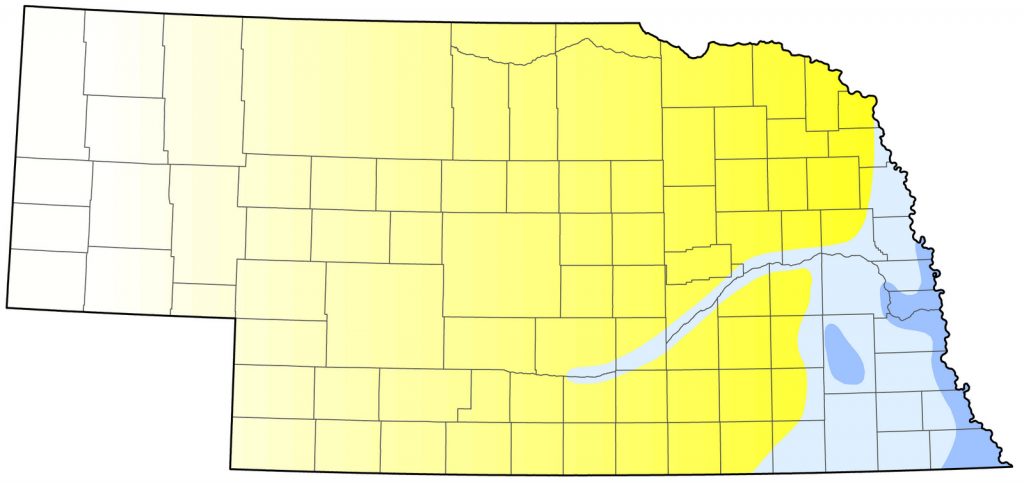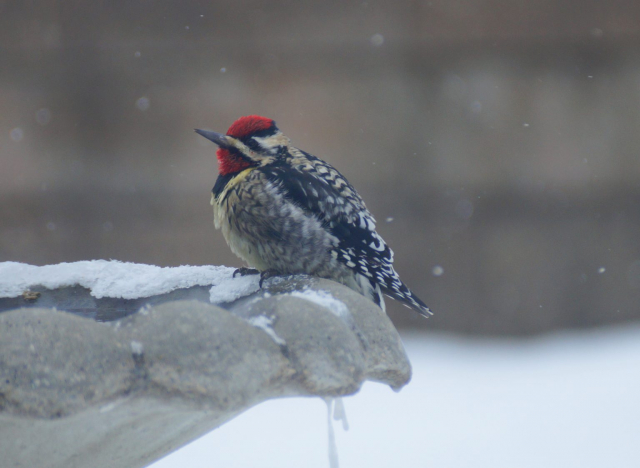Sphyrapicus varius
Status: Uncommon regular spring migrant east and central, rare casual west. Fairly common fall migrant east, uncommon central, rare west. Rare regular winter visitor southeast, rare casual elsewhere.

Documentation: Specimen: UNSM ZM6307, 9 Oct 1921 Lancaster Co.
Taxonomy: Yellow-bellied (S. varius), Red-naped (S. nuchalis), and Red-breasted (S. ruber) Sapsuckers are closely related, having diverged genetically from each other relatively recently. AOU (1957) treated them as subspecies of Yellow-bellied Sapsucker, but they have each been more recently considered full species (Walters et al 2020).
No subspecies of S. varius are recognized (AviList 2025).
It should be noted that reports from western Nebraska in the 1980s, prior to the split to three species, included Red-naped Sapsucker as a subspecies of Yellow-bellied Sapsucker.
Hybridization with Red-naped Sapsucker is discussed at Hybrids – Birds of Nebraska – Online (outdoornebraska.gov).
A red-throated sapsucker in Douglas Co 26 May 2025 with red feathering on its nape and a small patch of white on its chin, was initially identified as a female Red-naped, then by others as a young male Yellow-bellied. Most characters used to separate these age classes/species (for example Mlodinow et al 2006) were equivocal on the Omaha bird based on checklist photos (eBird Checklist – 26 May 2025; eBird Checklist – 26 May 2025; eBird Checklist – 29 May 2025). One possible differentiating feature is molt timing; if correctly discerned, retention of juvenile chest shield (bib) feathering into spring might indicate Yellow-bellied Sapsucker, although since this molt is the last of the post-juvenile molt progression in sapsuckers, extending rather late even in Red-naped Sapsucker, it also is an equivocal feature on the Omaha bird. The possibility of a hybrid remains, but was thought doubtful since an individual hybrid would be unlikely to mix features of both sexes.
Spring: winter <<<>>> May 3, 4, 5
Later dates are 7 May 2010 Dodge Co, 13 May 2016 Sioux Co, 13 May 2021 Fontenelle Forest, Sarpy Co, and 19 May 2006 York Co.
Migration peaks in late Mar and early Apr. Arrival of migrants is difficult to discern, especially in the southeast, due to the presence of wintering birds, but the earliest migrants probably appear around 10-15 Mar. One was in Garfield Co 9 Mar 2016. Early spring dates in South Dakota are 19-28 Mar (Tallman et al 2002).
There is no evidence for summering or nesting in Nebraska, even though this species nests in extreme southeastern South Dakota (Tallman et al 2002) and in northwest Iowa (Kent and Dinsmore 1996). Eggs are laid in the breeding range in late May and early Jun, and so sightings at this time, especially in northeastern Nebraska, suggest possible breeding: 25 May 2025 Cedar Co, 29 May 2022 Sarpy Co, 31 May 2016 Lancaster Co, 31 May 2021 Sarpy Co, 21 Jun 2020 Washington Co, 30 Jun 2001 Lancaster Co, and 1 Jul 1993 Sarpy Co.
Spring migrants are far less numerous westward than in fall. In the Panhandle, there are only about 14 spring reports, in the period 7 Mar-21 May.
Fall: Sep 20, 21, 22 <<<>>> winter
Earlier dates are 3 Sep 2019 Dakota Co, 11 Sep 2024 Lancaster Co, and 15 Sep 2012, a juvenile at Fontenelle Forest, Sarpy Co.
The number of reports during fall migration and winter and in western and central Nebraska has increased remarkably since 2000. Of the 30 reports for Dec-Feb in central Nebraska, 25 have occurred since 2000. Of a total of 96 sapsuckers counted on CBCs 1967-68 through 1992-93, only five (5%) were north and west of Kearney and DeSoto NWR, but in the six CBC years 2010-2015, 11 of 57 (19%) were north and west of those locations. An indication of how much the status has changed in the last 20 years is this statement from the 1995 Spring Seasonal Report in Nebraska Bird Review (Silcock 1995): “An uncommon migrant, mainly in the Missouri River Valley, … Another was rather westerly and rather late in Saline Co….”. Some older western reports, especially in Sep, are likely referable to Red-naped Sapsuckers.
In the west this species is more frequently reported in fall than in spring, although it is still less than annual there. Records there are 20 Sep and 6 Oct 2024 juvenile Oliver Reservoir, KImball Co, 22 Sep 2015 Dawes Co, 10 Oct 2023 juvenile Kimball Co, 13 Oct 2016 Dawes Co, 26 Oct 2020 Scotts Bluff Co, and 21 Nov 2022 Thomas Co.
Peak movement is in the first half of Oct, but by the time of the CBC period in mid-late Dec, most sapsuckers are in the southeast although records are widely scattered over the southeastern half of the state. CBC data suggest that westerly sightings have increased in recent years; of a total of 96 counted on CBCs 1967-68 through 1992-93, only five (5%) were north and west of Kearney, Buffalo Co and DeSoto NWR, Washington Co, but during 2010-2015, 11 of 57 (19%) were north and west of those locations. Highest CBC counts are eight at Tristate (at Arbor Lodge SHP) 1981-82, seven in Omaha 1979-80, and six at Branched Oak Lake-Seward 16 Dec 2012.
Reports were numerous in fall 2015, when at least 40 individuals were reported, notably 11 in a trip through Boone, Platte, and Nance Cos 3 Oct and seven in about five hours’ birding in Fillmore, Thayer, and Jefferson Co the same day. Almost all of the reports were from the east, but singles were in Custer Co 16 Oct and 28 Nov, the latter an immature.
- High counts: 11 in a sweep through Boone, Platte, and Nance Cos 3 Oct 2015, 4 at Fontenelle Forest, Sarpy Co 2 Oct 2018, 3 at Wyuka Cemetery, Lincoln, Lancaster Co 14 Oct 1996 and 3 at Branched Oak Lake, Lancaster Co 5 Nov 2012.
Winter: Wintering birds occur in the southeast in varying numbers. In the winters 2000-2001 through 2014-2015, CBC data show 21 in 2004-2005 as the high total for the state, and low a single bird in 2002-2003; the average for the 10 winters with numbers cited was 9.6. Most reports for Dec-Feb are in Dec, declining through Feb; in 2003-2004, 15 were counted, nine in Dec, four in Jan, and two in Feb.
As of winter 2022-2023, there were 55 records for Dec-Mar in the central, about half of these in Dec and the remainder evenly spread through Jan-Mar. No fewer than 50 of the 55 records have occurred since 2000.
There are only these Dec-Feb reports from the west and west-central: 10 Dec 2012 and 3 Jan 2016 Hooker Co, 26 Oct-12 Dec 2020 juvenile Kimball Co, 18 Dec 2024 Lincoln Co, 23 Dec 2019 Scotts Bluff Co, 28 Dec 2024 Lake Ogallala, Keith Co, 10 Jan 1976 Scotts Bluff Co, 1 Nov 2019-11 Jan 2020 Gering, Scotts Bluff Co, 11-25 Jan 2024 Valentine, Cherry Co, 19 Jan-11 Mar 2019 juvenile Lincoln Co, 9 Feb 2024 (2) Swanson Reservoir, Hitchcock Co, 18 Feb 2010 an immature male in Cheyenne Co., and 24 Feb 2023 Lincoln Co.
Comments: Red-breasted Sapsucker (S. ruber) is a related species that occurs along the Pacific Coast of North America. A sapsucker with a “red head and breast” was observed near Odessa, Buffalo Co 29 Mar 2004 but could not be relocated. It seems most likely to have been a variant Yellow-bellied Sapsucker, although a male Red-breasted Sapsucker was photographed in Pottawattamie Co, Iowa, 6 Dec 2006 (IOURC).
A juvenile male collected at Chadron, Dawes Co 23 Sep 1919 (UNSM ZM6312), labeled as a Red-naped Sapsucker, is more likely a Yellow-bellied; see discussion in the Red-naped Sapsucker account.
Images
Abbreviations
CBC: Christmas Bird Count
IOURC: Iowa Ornithologists’ Union Records Committee
NWR: National Wildlife Refuge
SHP: State Historical Park
UNSM: University of Nebraska State Museum
Literature Cited
American Ornithologists’ Union [AOU]. 1957. The AOU Check-list of North American birds, 5th ed. Port City Press, Baltimore, Maryland, USA.
AviList Core Team, 2025. AviList: The Global Avian Checklist, v2025. https://doi.org/10.2173/avilist.v2025.
Kent, T.H., and J.J. Dinsmore. 1996. Birds in Iowa. Publshed by the authors, Iowa City and Ames, Iowa, USA.
Mlodinow, S.G., J.H. Barry, and C.D. Cox. 2006. Variation in red-naped and yellow-bellied sapsuckers. Birding 38: 42-51.
Silcock, W.R. 1995. Spring Field Report, March-May 1995. NBR 63: 34-60.
Tallman, D.A., Swanson, D.L., and J.S. Palmer. 2002. Birds of South Dakota. Midstates/Quality Quick Print, Aberdeen, South Dakota, USA.
Walters, E.L., E.H. Miller, and P.E. Lowther. 2020. Yellow-bellied Sapsucker (Sphyrapicus varius), version 1.0. In Birds of the World (A. F. Poole and F. B. Gill, Editors). Cornell Lab of Ornithology, Ithaca, NY, USA. https://doi.org/10.2173/bow.yebsap.01.
Recommended Citation
Silcock, W.R., and J.G. Jorgensen. 2025. Yellow-bellied Sapsucker (Sphyrapicus varius). In Birds of Nebraska — Online. www.BirdsofNebraska.org
Birds of Nebraska – Online
Updated 1 Aug 2025

